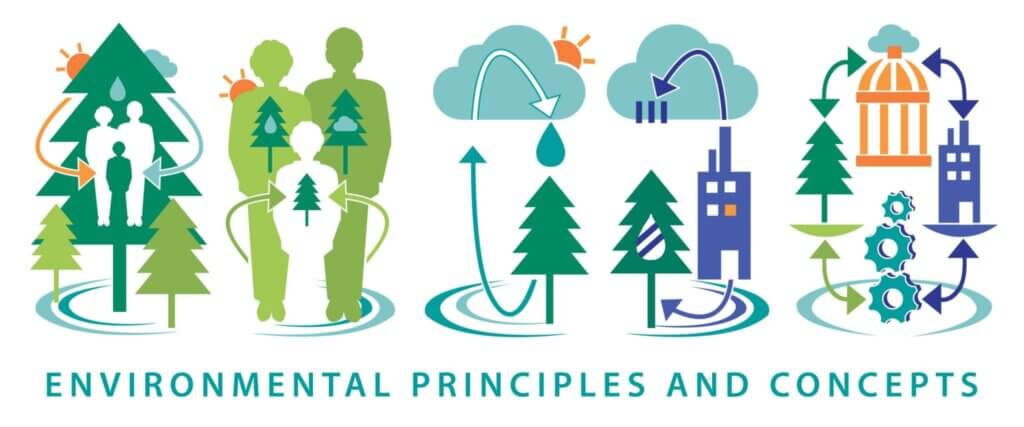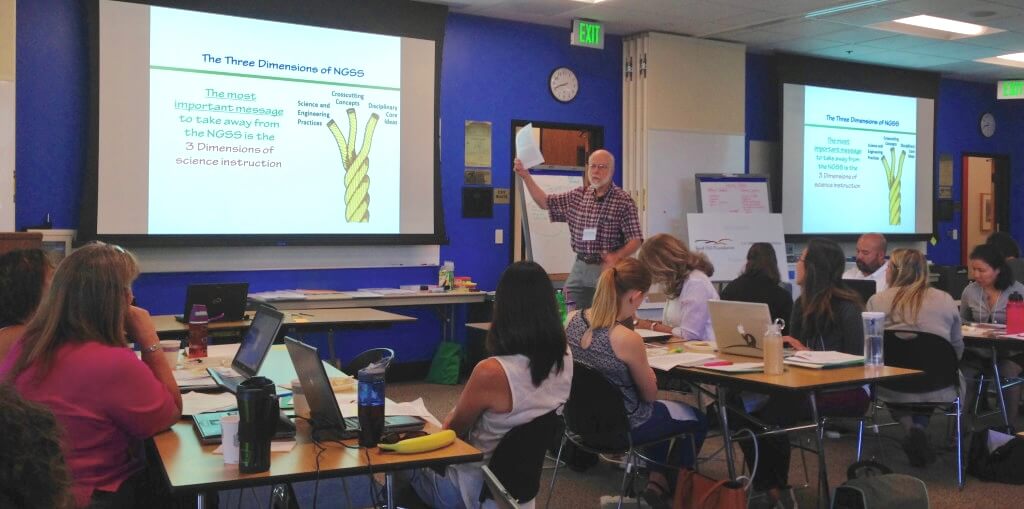Let’s celebrate the 20th anniversary of California’s Environmental Principles and Concepts (EP&Cs)!

Why is this milestone worth celebrating?
If you’re unfamiliar with California’s EP&Cs, don’t worry—you’re not alone. This is an opportunity to learn about something very important related to environmental literacy.
When I talk to educators about California’s EP&Cs, many share that they haven’t heard of them yet. Naturally, this sparks curiosity, and I often hear questions like these:
- What are California’s EP&Cs?
- Where did the EP&Cs come from?
- Who says the EP&Cs are important?
- How do the EP&Cs fit into California’s education system?
- How can the EP&Cs support my work when discussing environmental literacy with teachers, administrators, schools, and districts?
Stay tuned as we explore these questions further and celebrate the legacy and future of California’s EP&Cs. By the end of this article, I hope you’ll be inspired to say, “Wow, California’s EP&Cs are really important. They are woven throughout California’s K–12 education system and can powerfully support my work!”
What are California’s EP&Cs?
The version of the EP&Cs adopted by the State Board of Education are as follows:
Principle I. The continuation and health of individual human lives and of human communities and societies depend on the health of the natural systems that provide essential goods and ecosystem services. (I.e., People depend on natural systems)
Principle II. The long-term functioning and health of terrestrial, freshwater, coastal and marine ecosystems are influenced by their relationships with human society. (I.e., People influence natural systems)
Principle III. Natural systems proceed through cycles that humans depend upon, benefit from, and can alter. (I.e., Natural systems change in ways that people benefit from and can influence)
Principle IV. The exchange of matter between natural systems and human societies affects the long-term functioning of both. (I.e., There are no permanent or impermeable boundaries that prevent matter from flowing between systems)
Principle V. Decisions affecting resources and natural systems are based on a wide range of considerations and decision-making processes. (I.e., Decisions affecting resources and natural systems are complex and involve many factors)
The EP&Cs were written so they could easily connect to a wide variety of environmental topics and issues—for example, Principle IV. The exchange of matter between natural systems and human societies . . . encompasses environmental pollution and waste management issues. (Note: The writing style used for the EP&Cs conformed to the SBE’s style for academic content standards when adopted in 2004.)
Where did the EP&Cs come from?
California’s Environmental Principles and Concepts were created after the legislature wrote and the governor signed AB 1548 in 2003. This followed months of work by Leslie Tamminen, the then-legislative director of Heal the Bay in Santa Monica.
AB 1548, of course, contained a variety of provisions, but the most important were:
- establishing the Office of Education and the Environment (OEE) in the California Integrated Waste Management Board (now CalRecycle) under CalEPA
- calling for the development of “education principles for the environment,” and
- the development of a “model curriculum” (now the Education and Environment Initiative [EEI] Curriculum).
The idea of education principles for the environment quickly evolved into a plan for developing California’s Environmental Principles and Concepts.
The EP&Cs were developed in 2004 through extensive meetings involving stakeholder groups from state and federal agencies, university faculty and researchers, environmental NGOs, and representatives of state education agencies. The draft versions of the EP&Cs were then vetted through a variety of opportunities for public comment, including an extensive series of focus group meetings from Eureka to San Diego and public hearings under the aegis of the State Board of Education, CalEPA, and the California Integrated Waste Management Board.
In December 2004, the official version of the EP&Cs was adopted by the State Board of Education, CalEPA, and the California Integrated Waste Management Board (now CalRecycle).
Who says the EP&Cs are important?
Many influential entities recognize the significance of the EP&Cs:
- The State Board of Education (SBE) and California Department of Education (CDE)
- The California Legislature, through landmark legislation like AB-1548 (Pavley, 2003) and SB 720 (Allen, 2018)
- Governors Arnold Schwarzenegger and Gavin Newsom
- The California Environmental Protection Agency (CalEPA) and California Natural Resources Agency (CNRA)
- SBE-adopted curriculum frameworks for Science, Math, History-Social Science, Health, Visual and Performing Arts, and World Languages
- SBE guidelines for adopting instructional materials at the state and school district levels
Most notably, SB 720 (Allen, 2018) declared the EP&Cs as “fundamental to the definition of environmental literacy in California.” This legislation updated Education Code Section 51227.3, requiring that the EP&Cs be integrated into content standards and curriculum frameworks for Science, History-Social Science, Mathematics, English-Language Arts, and Health. It also instructed the SBE to include the EP&Cs in its textbook adoption criteria for these subjects.

This milestone reaffirms the critical role the EP&Cs play in shaping a generation of environmentally literate students and supporting educators in making a lasting impact on their communities.
How do the EP&Cs fit into California’s education system?
The Science Framework for California Public Schools: Kindergarten Through Grade Twelve, adopted by the California State Board of Education in 2016, provides a concise answer to this question. It calls for the following:
Explicit Focus on Environmental Principles and Concepts. A direct understanding of the connections between humans and the natural world prepares students to address the environmental challenges of today and of the future, to mitigate and prepare for natural hazards, and to interact in a responsible and sustainable manner with the natural systems that support all life. California has identified several critical understandings, called the Environmental Principles and Concepts, that every student in the state should learn and be able to apply. The State Board of Education (SBE) officially adopted the EP&Cs in 2004 and they are an important piece of the curricular expectations for all California students.
The State Board of Education and Department of Education further demonstrated California’s commitment to the EP&Cs and environmental literacy by incorporating them into the curriculum frameworks for History-Social Science, Math, Health, Visual and Performing Arts, and World Languages—in addition to Science.
This was followed by the SBE incorporating the EP&Cs into its “Instructional Materials Adoption Criteria,” the documents used to guide publishers, the instructional materials review panels, and the decisions of the Curriculum and Supplemental Materials Commission. School districts then use this same guidance to decide which instructional materials will be used in their K–8 classrooms.

How can the EP&Cs support my work when discussing environmental literacy with teachers, administrators, schools, and districts?
If you have ever talked to teachers, principals, or school or district administrators about this topic, you are likely to have been asked, “How do outdoor learning experiences and learning about the environment connect to what we are supposed to be doing in school?” Or perhaps you have been told, “Our teachers and students don’t have the time to be involved in environmental literacy work.”
Hopefully, the information above gives you some of the tools you’ll need to explain that the EP&Cs and environmental literacy are
- “an important piece of the curricular expectations for all California students” (State Board of Education adopted Science Framework for California Public Schools: Kindergarten Through Grade Twelve [2016]);
- “fundamental to the definition of environmental literacy in California” (SB 720 [2018]);
- incorporated into the SBE-adopted curriculum frameworks for Science, Math, History-Social Science, Health, Visual and Performing Arts, and World Languages;
- an important component of the SBE-approved guidelines for adopting instructional materials at the state and school district levels; and
- an integral part of the California Science Test Blueprint (State Board of Education [2017]). In addition, as of 2025, California’s science assessment will be a major component of the California School Dashboard, which provides parents and educators with information about school and district progress so they can be involved in decisions to improve student learning.
A recent report by The Lawrence Hall of Science, Ten Strands, and the California Environmental Literacy Initiative revealed that 83 percent of educators and 84 percent of administrators want to provide more environmental literacy opportunities for their students. With the many competing demands on instructional time, the EP&Cs offer a practical solution. Instead of adding to teachers’ workloads, they provide a framework for integrating environment-based thinking into core subjects, making learning meaningful and efficient.
So, please join Ten Strands and I as we celebrate the 20th anniversary of California’s Environmental Principles and Concepts and continue the work to inform educators about how they can build their students’ environmental literacy.

